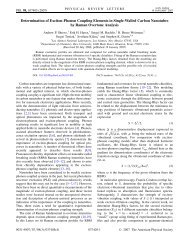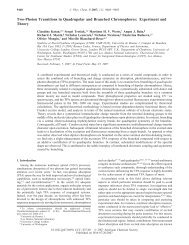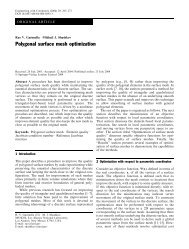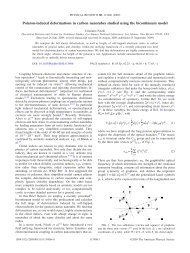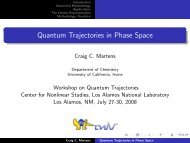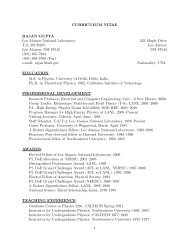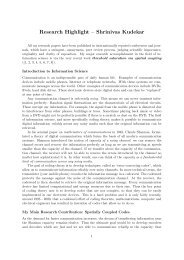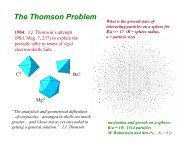Exciton scattering and localization in branched dendrimeric structures
Exciton scattering and localization in branched dendrimeric structures
Exciton scattering and localization in branched dendrimeric structures
Create successful ePaper yourself
Turn your PDF publications into a flip-book with our unique Google optimized e-Paper software.
<strong>Exciton</strong> <strong>scatter<strong>in</strong>g</strong> <strong>and</strong> <strong>localization</strong> <strong>in</strong><br />
<strong>branched</strong> <strong>dendrimeric</strong> <strong>structures</strong><br />
ARTICLES<br />
CHAO WU 1 ,SERGEYV.MALININ 1 , SERGEI TRETIAK 2 * AND VLADIMIR Y. CHERNYAK 1 *<br />
1 Department of Chemistry, Wayne State University, 5101 Cass Ave, Detroit, Michigan 48202, USA<br />
2 Theoretical Division, Center for Nonl<strong>in</strong>ear Studies, <strong>and</strong> Center for Integrated Nanotechnologies, Los Alamos National Laboratory, Los Alamos, New Mexico 87545, USA<br />
*e-mail: serg@lanl.gov; chernyak@chem.wayne.edu<br />
Published onl<strong>in</strong>e: 27 August 2006; doi:10.1038/nphys389<br />
π-conjugated dendrimers are molecular examples<br />
of tree-like <strong>structures</strong> known <strong>in</strong> physics as Bethe<br />
lattices. Electronic excitations <strong>in</strong> these systems can<br />
be spatially delocalized or localized depend<strong>in</strong>g on the<br />
branch<strong>in</strong>g topology. Without a priori knowledge of<br />
the <strong>localization</strong> pattern, underst<strong>and</strong><strong>in</strong>g photoexcitation<br />
dynamics reflected <strong>in</strong> experimental optical spectra<br />
is difficult. ‘Supramolecular’-like quantum-chemical<br />
calculations quickly become <strong>in</strong>tractable as the molecular<br />
size <strong>in</strong>creases. Here we develop a reduced exciton<strong>scatter<strong>in</strong>g</strong><br />
(ES) model, which attributes excited<br />
states to st<strong>and</strong><strong>in</strong>g waves <strong>in</strong> quasi-one-dimensional<br />
<strong>structures</strong>, assum<strong>in</strong>g a quasiparticle picture of optical<br />
excitations. Direct quantum-chemical calculations of<br />
<strong>branched</strong> phenylacetylene chromophores are used to<br />
verify our model <strong>and</strong> to derive relevant parameters.<br />
Complex <strong>and</strong> non-trivial de<strong>localization</strong> patterns of<br />
photoexcitations throughout the entire molecular tree<br />
can then be universally characterized <strong>and</strong> understood<br />
us<strong>in</strong>g the proposed ES method, completely bypass<strong>in</strong>g<br />
‘supramolecular’ calculations. This allows accurate<br />
modell<strong>in</strong>g of excited-state dynamics <strong>in</strong> arbitrary<br />
<strong>branched</strong> <strong>structures</strong>.<br />
Conjugated polymers <strong>and</strong> molecular wires are promis<strong>in</strong>g<br />
materials for a number of technological applications,<br />
such as light-emitt<strong>in</strong>g, las<strong>in</strong>g <strong>and</strong> molecular electronics<br />
applications 1,2 . Their extended one-dimensional backbones<br />
support delocalized mobile π-electron systems. This results<br />
<strong>in</strong> a semiconductor-like electronic structure, which may be<br />
manipulated synthetically. Branch<strong>in</strong>g of l<strong>in</strong>ear cha<strong>in</strong>s produces<br />
tree-like molecules (dendrimers) that can be used to extend<br />
desirable electronic properties even further 3,4 . In particular,<br />
dendrimers are believed to be promis<strong>in</strong>g build<strong>in</strong>g blocks for<br />
artificial light-harvest<strong>in</strong>g systems 5–8 . These considerations are<br />
based on their unique geometric <strong>structures</strong> known as Cayley<br />
trees or Bethe lattices: as the dendrimer progresses to a higher<br />
generation, the exponentially <strong>in</strong>creas<strong>in</strong>g peripheral term<strong>in</strong>al<br />
chromophores serve as an antenna matrix to gather the <strong>in</strong>com<strong>in</strong>g<br />
light. The collected energy <strong>in</strong> the form of photogenerated electronic<br />
excitations is further funnelled to the core, where it can trigger<br />
chemical reactions. Cooperative enhancement of nonl<strong>in</strong>ear optical<br />
responses (such as two-photon absorption) <strong>in</strong> dendrimers is<br />
another currently active field of research 9,10 .<br />
Studies <strong>in</strong>vestigat<strong>in</strong>g artificial light-harvest<strong>in</strong>g functionality <strong>in</strong><br />
<strong>dendrimeric</strong> <strong>structures</strong> revealed a fasc<strong>in</strong>at<strong>in</strong>g <strong>in</strong>terplay between<br />
photoexcitation <strong>localization</strong>/de<strong>localization</strong> patterns <strong>and</strong> their<br />
energy-relaxation dynamics. In contrast to fluorescence resonance<br />
energy transfer from peripheral dyes directly to the core dye,<br />
observed <strong>in</strong> flexible polyarylether backboned dendrimers 5 , fully<br />
conjugated symmetrical globular phenylacetylene dendrimers 7,11<br />
transfer excitations sequentially through the conjugated net 12 .In<br />
the latter <strong>structures</strong>, l<strong>in</strong>ear oligomers form rigid monodendrons<br />
l<strong>in</strong>ked via meta-substituted phenyl r<strong>in</strong>gs. Meta-substitutions break<br />
the conjugation lead<strong>in</strong>g to efficient <strong>localization</strong> of photogenerated<br />
excitations <strong>in</strong> the l<strong>in</strong>ear segments 7,13–17 . The energy gradient is then<br />
automatically created as the core extends to higher generations<br />
with shorter phenylacetylene segments. The delicate <strong>in</strong>terplay<br />
of strong <strong>and</strong> weak coupl<strong>in</strong>g between l<strong>in</strong>ear chromophores<br />
has specific signatures <strong>in</strong> the temperature-dependent dynamics<br />
<strong>and</strong> vibrational system relaxation 16–18 . The ortho-substitution<br />
l<strong>in</strong>kage is less favourable relative to the meta one due to steric<br />
<strong>in</strong>teractions. However, several unsymmetrical dendrimers with few<br />
generations were recently synthesized by Peng <strong>and</strong> co-workers 8,19,20 .<br />
These use both ortho- <strong>and</strong> para-substituted phenyls as jo<strong>in</strong>ts<br />
to connect the phenylacetylene segments. As the optical <strong>and</strong><br />
nature physics VOL 2 SEPTEMBER 2006 www.nature.com/naturephysics 631<br />
©2006<br />
Nature Publish<strong>in</strong>g Group
ARTICLES<br />
a<br />
b<br />
P7<br />
M7-43<br />
O7-43<br />
36<br />
38<br />
D9-333<br />
R 6<br />
R 5<br />
2<br />
1 62<br />
3<br />
7<br />
M6-33<br />
34<br />
R 3<br />
R 1<br />
R 4<br />
C R2 R4 R1<br />
38<br />
1 36<br />
62<br />
3<br />
1<br />
R 2<br />
R 3<br />
R 3<br />
4<br />
30<br />
1 29<br />
4<br />
2<br />
1<br />
R 1<br />
P<br />
3<br />
O6-33<br />
28<br />
3<br />
R 2<br />
R 1<br />
R 3<br />
3<br />
R 5<br />
30<br />
26<br />
55<br />
30<br />
R 3<br />
N<br />
62<br />
3<br />
54<br />
3<br />
54<br />
3<br />
78<br />
3<br />
1<br />
R2<br />
R 4<br />
R 7 R 8<br />
R 1<br />
R 6<br />
R 2<br />
3<br />
1<br />
54<br />
3<br />
Figure 1 Supramolecular dendrimers are made up via branch<strong>in</strong>g of l<strong>in</strong>ear<br />
cha<strong>in</strong>s. a, Examples of branch<strong>in</strong>g centres. b, Structure <strong>and</strong> atom labell<strong>in</strong>g of the<br />
‘para’ P7, ‘meta’ M6-33 <strong>and</strong> M7-43, ‘ortho’ O6-33 <strong>and</strong> O7-43 <strong>and</strong> <strong>branched</strong> D9-333<br />
molecules considered <strong>in</strong> this article.<br />
photophysical properties of these systems are significantly different<br />
from those of symmetrical branch<strong>in</strong>g <strong>structures</strong>, the fundamental<br />
photoexcitation dynamics <strong>in</strong> unsymmetrical dendrimers could<br />
be different, <strong>and</strong> the energy-transfer mechanisms are not well<br />
understood 19,20 . Moreover, photoprocesses <strong>in</strong> compounds us<strong>in</strong>g<br />
alternatives to phenyl-based branch<strong>in</strong>g centres (for example,<br />
nitrogen or phosphorus) 9,10 have not been explored <strong>in</strong> detail,<br />
<strong>and</strong> the universal theoretical underst<strong>and</strong><strong>in</strong>g encompass<strong>in</strong>g all<br />
branch<strong>in</strong>g <strong>structures</strong> (several examples are shown <strong>in</strong> Fig. 1a) is yet<br />
to be determ<strong>in</strong>ed.<br />
EXCITON-SCATTERING MODEL<br />
We propose the exciton-<strong>scatter<strong>in</strong>g</strong> (ES) model to allow clear<br />
<strong>in</strong>terpretation of photoexcitation de<strong>localization</strong> <strong>in</strong> arbitrary<br />
<strong>branched</strong> <strong>structures</strong>. <strong>Exciton</strong>s <strong>in</strong> <strong>in</strong>f<strong>in</strong>itely long l<strong>in</strong>ear conjugated<br />
cha<strong>in</strong>s can be treated as quasiparticles with well-def<strong>in</strong>ed momenta.<br />
Excited states <strong>in</strong> f<strong>in</strong>ite systems have pronounced node structure <strong>and</strong><br />
can be related to the excitations with non-zero momenta 21 .For<br />
l<strong>in</strong>ear molecules, this correspondence was explored <strong>in</strong> the context<br />
of electron-energy-loss spectroscopy 22,23 . The ES approach extends<br />
these developments to a more general case <strong>and</strong> naturally attributes<br />
excited states <strong>in</strong> <strong>branched</strong> <strong>structures</strong> to st<strong>and</strong><strong>in</strong>g waves that result<br />
from exciton <strong>scatter<strong>in</strong>g</strong> at the molecular ends, jo<strong>in</strong>ts <strong>and</strong> branch<strong>in</strong>g<br />
vertices. The ES model rests on the assumption of decoupl<strong>in</strong>g<br />
between the centre-of-mass <strong>and</strong> relative motion of electron–hole<br />
pairs <strong>and</strong> is asymptotically exact <strong>in</strong> the limit of the exciton size be<strong>in</strong>g<br />
short compared with the l<strong>in</strong>ear segment lengths. Any <strong>branched</strong><br />
organic molecule is then treated as a graph 24 . The excited states are<br />
represented by wavefunctions ψ s(x) = a sexp(ikx s)+b sexp(−ikx s)<br />
of the exciton centre-of-mass position x s on the segments. These<br />
two plane waves describe the quantum quasiparticle motion <strong>in</strong> two<br />
possible directions <strong>in</strong> a l<strong>in</strong>ear segment. The wavevectors are related<br />
to the exciton frequencies through the exciton spectrum ω(k) <strong>in</strong> the<br />
<strong>in</strong>f<strong>in</strong>ite-length cha<strong>in</strong>s. In a vertex that connects n l<strong>in</strong>ear segments,<br />
the amplitudes of the outgo<strong>in</strong>g plane waves are related to the<br />
<strong>in</strong>com<strong>in</strong>g waves’ amplitudes through an n × n <strong>scatter<strong>in</strong>g</strong> matrix25 (ω). Naturally, the off-diagonal <strong>and</strong> diagonal elements of Γ<br />
Γ (n)<br />
rs<br />
describe transmission <strong>and</strong> reflection processes, respectively. The<br />
Frenkel exciton model seems to be the limit<strong>in</strong>g case <strong>in</strong> this<br />
approach, allow<strong>in</strong>g only for complete reflection or transmission.<br />
<strong>Exciton</strong> frequencies <strong>and</strong> wavefunctions can be found by solv<strong>in</strong>g a<br />
simple l<strong>in</strong>ear problem for the amplitudes as <strong>and</strong> bs. For a molecule<br />
represented by a graph with d1 edges (l<strong>in</strong>ear segments) we have 2d1 <strong>in</strong>dependent variables (amplitudes). At each vertex/branch<strong>in</strong>g a of<br />
degree na,wehavenal<strong>in</strong>ear equations that connect the amplitudes<br />
of the outgo<strong>in</strong>g waves <strong>in</strong> terms of their <strong>in</strong>com<strong>in</strong>g counterparts<br />
(na )<br />
through the elements of the <strong>scatter<strong>in</strong>g</strong> matrix Γ a . The number<br />
of l<strong>in</strong>ear equations <br />
a na = 2d1 exactly matches the number<br />
of variables, <strong>and</strong> we arrive at a l<strong>in</strong>ear homogeneous 2d1 × 2d1 frequency-dependent problem. The solution gives the transition<br />
frequencies of the excited states <strong>and</strong> the shapes of the st<strong>and</strong><strong>in</strong>g<br />
waves, conta<strong>in</strong><strong>in</strong>g all <strong>in</strong>formation on the electronic spectrum of<br />
a macromolecule.<br />
This provides a dramatic reduction <strong>in</strong> the computational<br />
effort compared with ‘supramolecular’-like quantum-chemical<br />
approaches <strong>and</strong> allows swift evaluation of novel organic materials<br />
for desirable electronic properties. On the other h<strong>and</strong>, the ES model<br />
builds on the high-quality electronic-structure calculations, such<br />
as time-dependent density functional theory26 , by request<strong>in</strong>g the<br />
electronic-structure data on l<strong>in</strong>ear segments <strong>and</strong> relevant vertices<br />
as an <strong>in</strong>put. This can be done rout<strong>in</strong>ely us<strong>in</strong>g st<strong>and</strong>ard quantumchemical<br />
codes <strong>and</strong> very modest computational resources. The<br />
chosen level of quantum chemistry can be rather arbitrary,<br />
however, it should be capable of describ<strong>in</strong>g excitonic effects <strong>in</strong> the<br />
excited states. <strong>Exciton</strong>s are vitally important for the description of<br />
excited-state structure <strong>and</strong> photo<strong>in</strong>duced dynamics <strong>in</strong> conjugated<br />
chromophores. These quasiparticles are fundamental objects <strong>in</strong><br />
the ES approach. Approaches on the basis of the local (or<br />
non-hybrid general gradient) density approximations, Hartree–<br />
Fock, or simpler tight-b<strong>in</strong>d<strong>in</strong>g (Hückel) models do not reproduce<br />
photoexcited bound states of electrons <strong>and</strong> holes27 , <strong>and</strong>, thus,<br />
should not be used <strong>in</strong> conjunction with our model.<br />
RESULTS OF QUANTUM-CHEMICAL CALCULATIONS<br />
To illustrate practical applications of the ES theoretical framework,<br />
we consider several phenylacetylene oligomers branch<strong>in</strong>g at<br />
para-, ortho- <strong>and</strong> meta-positions at substituted phenyl r<strong>in</strong>gs,<br />
as shown <strong>in</strong> Fig. 1b. Similar compounds have recently been<br />
explored experimentally 28 . The excited-state structure of these<br />
molecules was calculated quantum-chemically as described <strong>in</strong> the<br />
Methods section. The computed states are strongly delocalized π–π<br />
excitations, which are optically accessible <strong>and</strong> play a crucial role <strong>in</strong><br />
energy-transfer processes. Typically, the lowest-energy (b<strong>and</strong>gap)<br />
transition <strong>in</strong> such conjugated l<strong>in</strong>ear cha<strong>in</strong>s has remarkable<br />
oscillator strength <strong>and</strong> characteristically appears as a ma<strong>in</strong> peak <strong>in</strong><br />
the l<strong>in</strong>ear absorption spectra 29,30 . Figure 2 summarizes our ma<strong>in</strong><br />
computational results. The contour plots represent the transition<br />
density matrices (ξν)mn (also referred to as electronic normal<br />
632 nature physics VOL 2 SEPTEMBER 2006 www.nature.com/naturephysics<br />
©2006<br />
Nature Publish<strong>in</strong>g Group
P7<br />
D9-333 O6-33<br />
O7-43<br />
M6-33<br />
M7-43<br />
60 S1 Ω = 2.92 eV, f = 96<br />
48<br />
36<br />
24<br />
12<br />
1<br />
1 12 24 36 48 60<br />
60<br />
48<br />
36<br />
24<br />
12<br />
1<br />
1 12 24 36 48 60<br />
54<br />
48<br />
S1 Ω = 3.06 eV, f = 65<br />
36<br />
24<br />
12<br />
60<br />
48<br />
36<br />
24<br />
12<br />
S1 Ω = 3.01 eV, f = 72<br />
1<br />
1 12 24 36 4854<br />
S1 Ω = 2.94 eV, f = 30<br />
60<br />
48<br />
36<br />
24<br />
12<br />
1<br />
1<br />
1 12 24 36 48 60 1 12 24 36 48 60<br />
60<br />
48<br />
36<br />
24<br />
12<br />
1<br />
1 12 24 36 48 60<br />
1<br />
1 12 24 36 48 60<br />
1<br />
1 12 24 36 48 60<br />
54<br />
48<br />
S2 Ω = 3.15 eV, f = 19<br />
54<br />
48<br />
S9 Ω = 3.55 eV, f = 0<br />
54<br />
48<br />
S10 Ω = 3.56 eV, f = 0<br />
60<br />
48<br />
36<br />
24<br />
12<br />
S2 Ω = 3.11 eV, f = 0<br />
S2 Ω = 3.12 eV, f = 26 60<br />
48<br />
S7 Ω = 3.37 eV, f = 0<br />
S<br />
60<br />
60<br />
2 Ω = 3.11 eV, f = 58 S4 Ω = 3.31 eV, f = 4 S11 Ω = 3.52 eV, f = 0<br />
1<br />
1 12 24 36 48 60<br />
1<br />
1 12 24 36 48 60<br />
1<br />
1 12 24 36 48 60<br />
1<br />
1 12 24 36 48 60<br />
54<br />
48<br />
S1 Ω = 2.96 eV, f = 22<br />
54<br />
48<br />
S2 Ω = 3.17 eV, f = 53<br />
54<br />
48<br />
S8 Ω = 3.40 eV, f =1<br />
54<br />
48<br />
S10 Ω = 3.63 eV, f = 0<br />
36<br />
24<br />
12<br />
1<br />
1 12 24 36 4854<br />
1<br />
1 12 24 36 48 54<br />
1<br />
1 12 24 36 48 54<br />
1<br />
1 12 24 36 4854<br />
78<br />
72 S1 Ω = 2.89 eV, f = 49<br />
78<br />
72 S2 Ω = 3.05 eV, f = 59<br />
78<br />
72 S3 Ω = 3.20 eV, f = 11<br />
78<br />
72 S8 Ω = 3.35 eV, f = 6<br />
60<br />
48<br />
36<br />
24<br />
12<br />
36<br />
24<br />
12<br />
60<br />
48<br />
36<br />
24<br />
12<br />
36<br />
24<br />
12<br />
48<br />
36<br />
24<br />
12<br />
S3 Ω = 3.32 eV, f = 7<br />
60<br />
48<br />
36<br />
24<br />
12<br />
48<br />
36<br />
24<br />
12<br />
0.9–1.0<br />
0.7–0.8<br />
0.5–0.6<br />
0.3–0.4<br />
0.1–0.2<br />
0.8–0.9<br />
0.6–0.7<br />
0.4–0.5<br />
0.2–0.3<br />
0–0.1<br />
S11 Ω = 3.55 eV, f = 0<br />
1<br />
1<br />
1<br />
1 12 24 36 48 54 1 12 24 36 48 54 1 12 24 36 48 54<br />
36<br />
24<br />
12<br />
60<br />
48<br />
36<br />
24<br />
12<br />
1<br />
1<br />
1<br />
1<br />
1 12 24 36 48 60 7278 1 12 24 36 48 60 7278 1 12 24 36 48 60 7278 1 12 24 36 48 60 7278<br />
36<br />
24<br />
12<br />
36<br />
24<br />
12<br />
60<br />
48<br />
36<br />
24<br />
12<br />
36<br />
24<br />
12<br />
36<br />
24<br />
12<br />
60<br />
48<br />
36<br />
24<br />
12<br />
ARTICLES<br />
Figure 2 <strong>Exciton</strong>-<strong>scatter<strong>in</strong>g</strong> patterns given by contour plots of transition density matrices from the ground state to excited states of the molecules shown <strong>in</strong> Fig. 1.<br />
Each plot shows the probability amplitudes of an electron mov<strong>in</strong>g from one molecular position (horizontal axis) to another (vertical axis) on electronic excitation. The axis<br />
labels represent <strong>in</strong>dividual carbon atoms accord<strong>in</strong>g to the labell<strong>in</strong>g <strong>in</strong> Fig. 1. The <strong>in</strong>set <strong>in</strong> each plot shows the excited state number (for example, S11 is the eleventh s<strong>in</strong>glet<br />
state), its transition frequency Ω <strong>and</strong> oscillator strength f.<br />
modes) between the ground <strong>and</strong> electronically excited states, as<br />
‘topographic’ maps that reflect the s<strong>in</strong>gle-electron reduced density<br />
matrix changes on molecular photoexcitation 29,31 .<br />
To establish a reference po<strong>in</strong>t, we start with the l<strong>in</strong>ear cha<strong>in</strong> P7.<br />
The results are shown <strong>in</strong> the first row. S 1 represents the b<strong>and</strong>gap<br />
transition <strong>and</strong> can be associated with k = 0 momentum exciton <strong>in</strong><br />
the <strong>in</strong>f<strong>in</strong>ite cha<strong>in</strong> limit. The electron–hole pair created on optical<br />
excitation is delocalized over the entire cha<strong>in</strong> (diagonal <strong>in</strong> the plot).<br />
The exciton size (maximal distance between electron <strong>and</strong> hole) is<br />
about 3 repeat units (largest off-diagonal extent of the non-zero<br />
matrix area). The higher-frequency electronic transitions (S 2, S 3<br />
<strong>and</strong> so on) have characteristic node structure <strong>and</strong> correspond to<br />
the excitons with non-zero momenta.<br />
The second row <strong>in</strong> Fig. 2 shows excited states of M7-43.<br />
The meta-connection clearly breaks the molecule <strong>in</strong>to two l<strong>in</strong>ear<br />
segments. The excited states of the molecule, S 1 <strong>and</strong> S 2 (S 7 <strong>and</strong> S 11),<br />
nature physics VOL 2 SEPTEMBER 2006 www.nature.com/naturephysics 633<br />
©2006<br />
Nature Publish<strong>in</strong>g Group
ARTICLES<br />
directly correspond to S 1 (S 2) excitation of the l<strong>in</strong>ear oligomers P4<br />
<strong>and</strong> P3, respectively. An electrostatic coupl<strong>in</strong>g between S 1 <strong>and</strong> S 2<br />
of M7-43 can be related to the <strong>in</strong>teraction of transition dipoles of<br />
S 1 states of P4 <strong>and</strong> P3. This leads to shifts <strong>in</strong> the electronic energy<br />
levels, <strong>and</strong> slightly mixes S 1 states of P4 <strong>and</strong> P3. Ow<strong>in</strong>g to vanish<strong>in</strong>g<br />
oscillator strengths, this mix<strong>in</strong>g becomes weaker for higher-ly<strong>in</strong>g<br />
states S 7 <strong>and</strong> S 11. A very similar situation is observed <strong>in</strong> the second<br />
meta-compound M6-33, with the exception that the excitation<br />
energies of its l<strong>in</strong>ear segments P3 are the same. Subsequently, the<br />
lowest excited states S 1 <strong>and</strong> S 2 are coherent ‘plus’ <strong>and</strong> ‘m<strong>in</strong>us’<br />
superpositions of the S 1 (P3) excitations. These are Frenkel-type<br />
excitons 15,32 , characteristic for molecular aggregates. The splitt<strong>in</strong>g<br />
between S 1 <strong>and</strong> S 2 states of M6-33 measures the coupl<strong>in</strong>g strength.<br />
Both S 1 <strong>and</strong> S 2 states have non-zero oscillator strengths result<strong>in</strong>g as<br />
a vector sum of the correspond<strong>in</strong>g transition dipoles. Thus, metabased<br />
connections effectively break the branch<strong>in</strong>g structure <strong>in</strong>to a<br />
number of electrostatically <strong>in</strong>teract<strong>in</strong>g chromophores, which makes<br />
it possible to apply reduced Frenkel-like hamiltonian models 15,32 .<br />
Next, we analyse the properties of ortho-branch<strong>in</strong>g. The lowest<br />
state S 1 <strong>in</strong> both O7-43 <strong>and</strong> O6-33 looks very similar to the S 1<br />
state of the l<strong>in</strong>ear chromophore P7. The higher-ly<strong>in</strong>g excited states<br />
of O7-43 <strong>and</strong> O6-33 also have characteristic node <strong>structures</strong>,<br />
irrespective of the position of the ortho-jo<strong>in</strong>t along the cha<strong>in</strong><br />
(compare the fourth <strong>and</strong> fifth rows with the first row <strong>in</strong> Fig. 2).<br />
This clearly demonstrates that ortho-branch<strong>in</strong>g does not prevent<br />
exciton de<strong>localization</strong> <strong>and</strong> the excitation pattern is similar to that <strong>in</strong><br />
the l<strong>in</strong>ear cha<strong>in</strong>s. However, there are important differences between<br />
para- <strong>and</strong> ortho-connections. The second excited state S 2 <strong>in</strong> both<br />
O7-43 <strong>and</strong> O6-33 appears as the state with the largest oscillator<br />
strength <strong>in</strong> their spectra, whereas it is optically forbidden <strong>in</strong> the<br />
l<strong>in</strong>ear chromophore P7. At the same time, the b<strong>and</strong>gap state S 1 of<br />
O7-43 <strong>and</strong> O6-33 has a relatively small oscillator strength compared<br />
with that of P7. This redistribution of the oscillator strength among<br />
excitons <strong>in</strong> the b<strong>and</strong> is a manifestation of molecular geometry.<br />
Compared with the l<strong>in</strong>ear cha<strong>in</strong>s, where both parts contribute<br />
nearly evenly to the total oscillator strength of the S 1 state, the<br />
transition dipole of the S 1 state <strong>in</strong> the ortho-<strong>structures</strong> is reduced<br />
due to vector addition of the dipole components on the l<strong>in</strong>ear<br />
segments. Albeit the S 2 state ga<strong>in</strong>s strong oscillator strength for<br />
the same reason. Subsequently, states that are optically forbidden<br />
<strong>in</strong> the l<strong>in</strong>ear cha<strong>in</strong>s, can be experimentally detected <strong>in</strong> the ortho<strong>structures</strong>,<br />
whose l<strong>in</strong>ear absorptions are expected to have several<br />
low-ly<strong>in</strong>g peaks. In contrast to meta-compounds, which have<br />
<strong>in</strong>dependent <strong>in</strong>teract<strong>in</strong>g l<strong>in</strong>ear chromophores, these states <strong>in</strong> orthomolecules<br />
appear due to transfer of the oscillator strength to the<br />
high-ly<strong>in</strong>g excitons as a consequence of molecular geometry.<br />
After the methodological study of possible phenyl-based jo<strong>in</strong>ts,<br />
we consider a comb<strong>in</strong>ed structure D9-333 (Fig. 1b). The bottom<br />
row of Fig. 2 shows transition density matrices of the optically<br />
relevant excited states. Unlike previous cases, their <strong>in</strong>terpretation<br />
us<strong>in</strong>g the de<strong>localization</strong>/<strong>localization</strong> language 14,15 does not look<br />
straightforward. For example, ortho-branch<strong>in</strong>g assumes fully<br />
delocalized states, whereas S 2 shows clear <strong>localization</strong> trends.<br />
APPLICATION OF EXCITON-SCATTERING MODEL<br />
The ES approach allows a uniform <strong>in</strong>terpretation of all molecular<br />
examples considered (Fig. 1b). The ES system of l<strong>in</strong>ear equations<br />
adopts the form:<br />
b sexp(−ikl s) = Γ (1) (ω)a sexp(ikl s); a s = <br />
r<br />
Γ (n)<br />
sr (ω)br.<br />
where l s are the l<strong>in</strong>ear segment lengths; n = 2 for M <strong>and</strong> O<br />
molecules <strong>and</strong> n = 3 for the D <strong>branched</strong> structure. In the latter case<br />
r,s = 1,2,3 correspond to the right, left <strong>and</strong> upper l<strong>in</strong>ear segments,<br />
respectively. A qualitatively correct zero-order approximation<br />
for the <strong>scatter<strong>in</strong>g</strong> matrix Γ can be readily constructed. The<br />
molecular end is a vertex with n = 1. Vanish<strong>in</strong>g of the excitonic<br />
wavefunction at the ends implies full reflection Γ (1) =−1. The<br />
central vertex of M molecules is described by a 2 × 2 <strong>scatter<strong>in</strong>g</strong><br />
matrix Γ (meta)<br />
12 = Γ (meta)<br />
21 = 0, Γ (meta)<br />
11 = Γ (meta)<br />
22 =−1, which accounts<br />
for the full reflection at meta-connection. The full transmission<br />
of ortho-vertex <strong>in</strong> O compounds implies: Γ (ortho)<br />
12 = Γ (ortho)<br />
21 = 1,<br />
Γ (ortho)<br />
11 = Γ (ortho)<br />
22 = 0. This assignment immediately rationalizes<br />
similarity <strong>in</strong> the shapes <strong>and</strong> energies between the S2 (M6-33) <strong>and</strong><br />
S2 (O6-33), or S10 (M6-33) <strong>and</strong> S10 (O6-33) states (see Fig. 2):<br />
they have the same excitonic wavefunction. The small differences<br />
can be attributed to deviations <strong>in</strong> the <strong>scatter<strong>in</strong>g</strong> matrices from the<br />
zero-order approximation due to, for example, steric <strong>in</strong>teractions.<br />
We further illustrate our ES model for the D9-333 molecule.<br />
The analogous rationale can be applied to derive the <strong>scatter<strong>in</strong>g</strong><br />
matrix for an arbitrary branch<strong>in</strong>g centre. Similar properties of<br />
para- <strong>and</strong> ortho-jo<strong>in</strong>ts (to the zero-order approximation) imply<br />
symmetry of the <strong>scatter<strong>in</strong>g</strong> matrix Γ (3)<br />
rs with respect to <strong>in</strong>terchange<br />
of branches 2 (left) <strong>and</strong> 3 (upper) of D9-333 (red labels <strong>in</strong> Fig. 1b),<br />
that is, Γ (3)<br />
22 = Γ (3)<br />
33 , Γ (3)<br />
23 = Γ (3)<br />
32 , Γ (3)<br />
12 = Γ (3)<br />
13 <strong>and</strong> Γ (3)<br />
21 = Γ (3)<br />
31 .<br />
This leaves us with five <strong>in</strong>dependent components of the <strong>scatter<strong>in</strong>g</strong><br />
matrix: Γ (3)<br />
11 , Γ (3)<br />
22 , Γ (3)<br />
23 , Γ (3)<br />
12 <strong>and</strong> Γ (3)<br />
21 . <strong>Exciton</strong>ic wavefunctions can<br />
be classified by their parity with respect to <strong>in</strong>terchange of branches<br />
2 <strong>and</strong> 3. Odd exciton modes vanish on branch 1, they are fully<br />
characterized by the amplitudes a2 <strong>and</strong> b2 that can be found by<br />
solv<strong>in</strong>g a l<strong>in</strong>ear problem <strong>in</strong> an effective l<strong>in</strong>ear cha<strong>in</strong> that represents<br />
branch 2. The <strong>scatter<strong>in</strong>g</strong> amplitudes at the left <strong>and</strong> right ends are<br />
Γ (1) =−1 <strong>and</strong> Γ (−) = Γ (3)<br />
22 −Γ (3)<br />
23 , respectively. Even exciton modes<br />
are characterized by the amplitudes as <strong>and</strong> bs with s = 1,2. They<br />
can be found by solv<strong>in</strong>g a l<strong>in</strong>ear problem <strong>in</strong> an effective l<strong>in</strong>ear<br />
cha<strong>in</strong> that represents branches 1 <strong>and</strong> 2 with a jo<strong>in</strong>t <strong>in</strong> the centre.<br />
The jo<strong>in</strong>t is described by an effective 2 × 2 <strong>scatter<strong>in</strong>g</strong> matrix with<br />
the elements Γ (+)<br />
21 = √ 2Γ (3)<br />
21 , Γ (+)<br />
12 = √ 2Γ (3)<br />
12 , Γ (+)<br />
22 = Γ (3)<br />
22 + Γ (3)<br />
23<br />
<strong>and</strong> Γ (+)<br />
11 = Γ (3)<br />
11 . The para–ortho-jo<strong>in</strong>ts symmetry is confirmed<br />
by vanish<strong>in</strong>g of the S2 mode <strong>in</strong> D9-333 on the right branch<br />
<strong>and</strong> its strik<strong>in</strong>g similarity to the S1 mode <strong>in</strong> M6-33 <strong>in</strong> terms<br />
of shape, energy <strong>and</strong> oscillator strength. The similarity <strong>in</strong> the<br />
energy <strong>and</strong> oscillator strength means that the modes have similar<br />
wavefunctions, which implies Γ (−) = Γ (3)<br />
22 − Γ (3)<br />
23 =−1. The even<br />
modes S1, S3 <strong>and</strong> S8 of D9-333 have 0, 1 <strong>and</strong> 2 nodes <strong>in</strong> the effective<br />
l<strong>in</strong>ear molecule, as clearly seen from Fig. 2. They are similar <strong>in</strong><br />
terms of the shapes <strong>and</strong> energies to the S1, S2 <strong>and</strong> S8 modes,<br />
respectively, of the O6-33 molecule. This implies for the zero-order<br />
approximation Γ (+)<br />
11 = Γ (+)<br />
22 = 0 <strong>and</strong> Γ (+)<br />
12 = Γ (+)<br />
21 = 1. F<strong>in</strong>ally, we<br />
arrive at Γ (3)<br />
11 ≈ 0, Γ (3)<br />
12 ≈Γ (3)<br />
21 ≈ 1/ √ 2, Γ (3)<br />
22 ≈−1/2 <strong>and</strong> Γ (3)<br />
23 ≈ 1/2,<br />
which completes the <strong>scatter<strong>in</strong>g</strong> matrix form. The differences <strong>in</strong><br />
the correspond<strong>in</strong>g energies <strong>and</strong> irregularities <strong>in</strong> the node positions<br />
<strong>in</strong> D9-333 are attributed to the deviation of the <strong>scatter<strong>in</strong>g</strong> matrix<br />
Γ (3)<br />
rs from its simple zero-order approximation, which turns out to<br />
be small. Strong differences <strong>in</strong> the oscillator strengths are due to<br />
different geometries of these molecules.<br />
In conclusion, we establish stable <strong>and</strong> <strong>in</strong>tuitively clear<br />
relationships between the structure of optical excitations <strong>in</strong><br />
<strong>branched</strong> organic molecules <strong>and</strong> the underly<strong>in</strong>g molecular<br />
geometry. The excitation <strong>localization</strong>/de<strong>localization</strong> concept of<br />
molecular aggregates, previously successfully used for metaconjugated<br />
dendrimers 7,14–16 , fails <strong>in</strong> the case of general <strong>branched</strong><br />
<strong>structures</strong>, which <strong>in</strong>volve various comb<strong>in</strong>ations of jo<strong>in</strong>ts <strong>and</strong><br />
branch<strong>in</strong>g 5,9,17 . The proposed ES model provides simple, yet<br />
quantitatively correct, microscopic <strong>in</strong>sight <strong>in</strong>to electronic spectra<br />
<strong>in</strong> such quasi-one-dimensional organic <strong>structures</strong> with complex<br />
topology 3–5 . It is conceptually rem<strong>in</strong>iscent of the graph theory 24<br />
<strong>and</strong> the Hückel model applications 33,34 to chemical reactivity. The<br />
ES approach is based on very common-life concepts, such as wave<br />
634 nature physics VOL 2 SEPTEMBER 2006 www.nature.com/naturephysics<br />
©2006<br />
Nature Publish<strong>in</strong>g Group
propagation, <strong>scatter<strong>in</strong>g</strong> <strong>and</strong> reflection, as well as the formation of<br />
st<strong>and</strong><strong>in</strong>g waves, nodes <strong>and</strong> so on. This allows simple <strong>and</strong> clear<br />
visualization of non-trivial <strong>and</strong> often counter<strong>in</strong>tuitive quantummechanical<br />
phenomena <strong>in</strong>volved <strong>in</strong> the electronic structure of<br />
complex nanosized molecules. The ES picture is confirmed by<br />
direct quantum-chemical calculations, which show pronounced<br />
node structure of electronic modes, full reflection from meta-jo<strong>in</strong>ts<br />
<strong>and</strong> almost full transmission through ortho-connections, even<br />
for relatively short l<strong>in</strong>ear segments. Well-recognizable <strong>in</strong>terference<br />
patterns reflect the non-trivial structure of exciton <strong>scatter<strong>in</strong>g</strong> at<br />
branch<strong>in</strong>g vertices, which, <strong>in</strong> pr<strong>in</strong>ciple, could conta<strong>in</strong> all possible<br />
options, that is, a reflected as well as two or more transmitted waves.<br />
The reported results conta<strong>in</strong> a number of predictions that can be<br />
verified experimentally, for example, spectroscopic signatures of<br />
excitons with non-zero momenta <strong>in</strong> ortho-compounds appear<strong>in</strong>g<br />
due to molecular geometry. Even although we only consider the<br />
phenyl-centred branch<strong>in</strong>g case here, our approach is applicable to<br />
any structure with arbitrary branch<strong>in</strong>g centres 9,17 . We also note<br />
that the semi-empirical collective electronic oscillator technique 29,31<br />
used <strong>in</strong> this study on a prov<strong>in</strong>g-the-concept basis is a matter of<br />
convenience, rather than necessity. The <strong>scatter<strong>in</strong>g</strong> model can be<br />
easily coupled to any first-pr<strong>in</strong>ciple approach, where quantumchemical<br />
calculations of branch<strong>in</strong>g vertices <strong>and</strong> l<strong>in</strong>ear segments<br />
will provide a more accurate approximation for the <strong>scatter<strong>in</strong>g</strong><br />
matrices. This ensures a quantitatively correct description of<br />
complex electronic phenomena <strong>and</strong> overcomes many fundamental<br />
limitations (restricted parameterization or lack of many-body<br />
effects) of the previous reduced models, for example, the Hückel<br />
or Frenkel exciton model, while preserv<strong>in</strong>g their conceptual<br />
simplicity. Thus, the ES concept is an attractive approach to<br />
ga<strong>in</strong> fundamental underst<strong>and</strong><strong>in</strong>g of the excited-state electronic<br />
structure <strong>in</strong> complex <strong>branched</strong> molecules of general connectivity,<br />
<strong>and</strong> is likely to provide an efficient microscopic <strong>in</strong>sight for design<br />
<strong>and</strong> eng<strong>in</strong>eer<strong>in</strong>g of organic molecules with desired optical <strong>and</strong><br />
photophysical properties.<br />
METHODS<br />
We conducted quantum-chemical calculations of several model<br />
phenylacetylene oligomers <strong>in</strong> Fig. 1b. For the l<strong>in</strong>ear oligomer P7, the symbol P<br />
denotes para <strong>and</strong> 7 st<strong>and</strong>s for seven repeat units. The M6-33 (M7-43)<br />
compound represents a l<strong>in</strong>kage of two oligomers of three <strong>and</strong> three (four <strong>and</strong><br />
three) phenylacetylene repeat units at a meta-position. Similarly, O6-33 <strong>and</strong><br />
O7-43 exemplify possible ortho-connections of two l<strong>in</strong>ear segments. F<strong>in</strong>ally,<br />
D9-333 is a comb<strong>in</strong>ation of para-, meta- <strong>and</strong> ortho-l<strong>in</strong>kages with three arms,<br />
which is a branch<strong>in</strong>g segment of an unsymmetrical dendrimer.<br />
The ground-state geometries of all molecules (Fig. 1b) were optimized<br />
us<strong>in</strong>g the Gaussian 03 35 package at the AM1 semi-empirical level. The<br />
geometry optimization resulted <strong>in</strong> planar molecular <strong>structures</strong>. Some<br />
conformational disorder is expected <strong>in</strong> real materials due to solvent <strong>and</strong><br />
temperature effects 7,13–17 . Several lowest optically relevant excited states were<br />
then calculated us<strong>in</strong>g the time-dependent Hartree–Fock approximation <strong>in</strong><br />
comb<strong>in</strong>ation with the <strong>in</strong>termediate neglect of differential overlap/spectroscopy<br />
(INDO/S) hamiltonian as implemented <strong>in</strong> the collective electronic oscillator<br />
code 30,31 . This approach worked quite accurately <strong>in</strong> the past for<br />
similar chromophores 14,29,31 .<br />
These calculations characterize each excited state via the vertical excitation<br />
energy, optical oscillator strength <strong>and</strong> electronic transition density matrix (or<br />
electronic normal mode). The latter bears important <strong>in</strong>formation on the<br />
changes <strong>in</strong> the molecular density <strong>and</strong> coherences <strong>in</strong>duced on optical excitation.<br />
This can be visualized us<strong>in</strong>g a two-dimensional real-space representation<br />
(Fig. 2). With<strong>in</strong> the time-dependent Hartree–Fock approach, the diagonal<br />
elements (ξν)nn of the matrices describe the net charge <strong>in</strong>duced <strong>in</strong> the nth<br />
atom by the external field. The off-diagonal elements (ξν)mn with m = n<br />
represent the jo<strong>in</strong>t probability amplitude of f<strong>in</strong>d<strong>in</strong>g an electron <strong>and</strong> a hole<br />
located at the mth <strong>and</strong> nth atoms, respectively 31 . Thus, the transition density<br />
ARTICLES<br />
matrices show the spatial extent of electronic transitions with optically <strong>in</strong>duced<br />
charges <strong>and</strong> electronic coherences.<br />
Received 22 March 2006; accepted 28 July 2006; published 27 August 2006.<br />
References<br />
1. Friend, R. H. et al. Electrolum<strong>in</strong>escence <strong>in</strong> conjugated polymers. Nature 397, 121–128 (1999).<br />
2. Forrest, S. R. The path to ubiquitous <strong>and</strong> low-cost organic electronic appliances on plastic. Nature<br />
428, 911–918 (2004).<br />
3. Percec, V. et al. Self-organization of supramolecular helical dendrimers <strong>in</strong>to complex electronic<br />
materials. Nature 419, 384–387 (2002).<br />
4. Yaliraki, S. N. & Ratner, M. A. Interplay of topology <strong>and</strong> chemical stability on the electronic transport<br />
of molecular junctions. Ann. NY Acad. Sci. 960, 153–162 (2002).<br />
5. Gilat, S. L., Adronov, A. & Frechet, J. M. J. Light harvest<strong>in</strong>g <strong>and</strong> energy transfer <strong>in</strong> novel convergently<br />
constructed dendrimers. Angew. Chem. Int. Edn 38, 1422–1427 (1999).<br />
6. Gust, D., Moore, T. A. & Moore, A. L. Mimick<strong>in</strong>g photosynthetic solar energy transduction. Acc.<br />
Chem. Res. 34, 40–48 (2001).<br />
7. Kopelman, R. et al. Spectroscopic evidence for excitonic <strong>localization</strong> <strong>in</strong> fractal antenna<br />
supermolecules. Phys.Rev.Lett.78, 1239–1242 (1997).<br />
8. Peng, Z. H., Pan, Y. C., Xu, B. B. & Zhang, J. H. Synthesis <strong>and</strong> optical properties of novel<br />
unsymmetrical conjugated dendrimers. J. Am. Chem. Soc. 122, 6619–6623 (2000).<br />
9. Goodson, T. G. Optical excitations <strong>in</strong> organic dendrimers <strong>in</strong>vestigated by time-resolved <strong>and</strong><br />
nonl<strong>in</strong>ear optical spectroscopy. Acc. Chem. Res. 38, 99–107 (2005).<br />
10. Goodson, T. G. Time-resolved spectroscopy of organic dendrimers <strong>and</strong> <strong>branched</strong> chromophores.<br />
Ann. Rev. Phys. Chem. 56, 581–603 (2005).<br />
11. Devadoss, C., Bharathi, P. & Moore, J. S. Energy transfer <strong>in</strong> dendritic macromolecules: Molecular size<br />
effects <strong>and</strong> the role of an energy gradient. J. Am. Chem. Soc. 118, 9635–9644 (1996).<br />
12. Heijs, D. J., Malyshev, V. A. & Knoester, J. Trapp<strong>in</strong>g time statistics <strong>and</strong> efficiency of transport of<br />
optical excitations <strong>in</strong> dendrimers. J. Chem. Phys. 121, 4884–4892 (2004).<br />
13. BarHaim, A., Klafter, J. & Kopelman, R. Dendrimers as controlled artificial energy antennae. J. Am.<br />
Chem. Soc. 119, 6197–6198 (1997).<br />
14. Tretiak, S., Chernyak, V. & Mukamel, S. Localized electronic excitations <strong>in</strong> phenylacetylene<br />
dendrimers. J. Phys. Chem. B 102, 3310–3315 (1998).<br />
15. Poliakov, E. Y., Chernyak, V., Tretiak, S. & Mukamel, S. <strong>Exciton</strong>-scal<strong>in</strong>g <strong>and</strong> optical excitations of<br />
self-similar phenylacetylene dendrimers. J. Chem. Phys. 110, 8161–8175 (1999).<br />
16. Thompson, A. L., Gaab, K. M., Xu, J. J., Bardeen, C. J. & Mart<strong>in</strong>ez, T. J. Variable electronic coupl<strong>in</strong>g <strong>in</strong><br />
phenylacetylene dendrimers: The role of Forster, Dexter, <strong>and</strong> charge-transfer <strong>in</strong>teractions. J. Phys.<br />
Chem. A 108, 671–682 (2004).<br />
17. Ortiz, W., Krueger, B. P., Kleiman, V. D., Krause, J. L. & Roitberg, A. E. Energy transfer <strong>in</strong> the<br />
nanostar: The role of coulombic coupl<strong>in</strong>g <strong>and</strong> dynamics. J. Phys. Chem. B 109, 11512–11519 (2005).<br />
18. Ortiz, W., Roitberg, A. E. & Krause, J. L. Molecular dynamics of poly(benzylphenyl ether) dendrimers:<br />
Effects of backfold<strong>in</strong>g on Forster energy-transfer rates. J. Phys. Chem. B 108, 8218–8225 (2004).<br />
19. Mel<strong>in</strong>ger, J. S. et al. Optical <strong>and</strong> photophysical properties of light-harvest<strong>in</strong>g phenylacetylene<br />
monodendrons based on unsymmetrical branch<strong>in</strong>g. J. Am. Chem. Soc. 124, 12002–12012 (2002).<br />
20. Atas, E., Peng, Z. H. & Kleiman, V. D. Energy transfer <strong>in</strong> unsymmetrical phenylene ethynylene<br />
dendrimers. J. Phys. Chem. B 109, 13553–13560 (2005).<br />
21. Tretiak, S., Saxena, A., Mart<strong>in</strong>, R. L. & Bishop, A. R. Intercha<strong>in</strong> electronic excitations <strong>in</strong><br />
poly(phenylenev<strong>in</strong>ylene) (PPV) aggregates. J. Phys. Chem. B 104, 7029–7037 (2000).<br />
22. Chernyak, V., Volkov, S. N. & Mukamel, S. <strong>Exciton</strong> coherence <strong>and</strong> electron energy loss spectroscopy<br />
of conjugated molecules. Phys.Rev.Lett.86, 995–998 (2001).<br />
23. Chernyak, V., Volkov, S. N. & Mukamel, S. Electronic structure-factor, density matrices, <strong>and</strong> electron<br />
energy loss spectroscopy of conjugated oligomers. J. Phys. Chem. A 105, 1988–2004 (2001).<br />
24. Bonchev, D. & Mekenyan, O. G. (eds) <strong>in</strong> Graph Theoretical Approaches to Chemical Reactivity<br />
(Kluwer Academic, Boston, 1994).<br />
25. Piryat<strong>in</strong>ski, A., Stepanov, M., Tretiak, S. & Chernyak, V. Semiclassical <strong>scatter<strong>in</strong>g</strong> on conical<br />
<strong>in</strong>tersections. Phys.Rev.Lett.95, 223001 (2005).<br />
26. Dreuw, A. & Head-Gordon, M. S<strong>in</strong>gle-reference ab <strong>in</strong>itio methods for the calculation of excited states<br />
of large molecules. Chem. Rev. 105, 4009–4037 (2005).<br />
27. Tretiak, S., Igumenshchev, K. & Chernyak, V. <strong>Exciton</strong> sizes of conduct<strong>in</strong>g polymers predicted by<br />
time-dependent density functional theory. Phys.Rev.B71, 33201 (2005).<br />
28. An<strong>and</strong>, S. et al. Optical excitations <strong>in</strong> carbon architectures based on<br />
dodecadehydrotribenzo[18]annulene. J. Phys. Chem. A 110, 1305–1318 (2006).<br />
29. Mukamel, S., Tretiak, S., Wagersreiter, T. & Chernyak, V. Electronic coherence <strong>and</strong> collective optical<br />
excitations of conjugated molecules. Science 277, 781–787 (1997).<br />
30. Tretiak, S., Saxena, A., Mart<strong>in</strong>, R. L. & Bishop, A. R. Conformational dynamics of photoexcited<br />
conjugated molecules. Phys.Rev.Lett.89, 097402 (2002).<br />
31. Tretiak, S. & Mukamel, S. Density matrix analysis <strong>and</strong> simulation of electronic excitations <strong>in</strong><br />
conjugated <strong>and</strong> aggregated molecules. Chem. Rev. 102, 3171–3212 (2002).<br />
32. Jang, S. J. & Silbey, R. J. Theory of s<strong>in</strong>gle molecule l<strong>in</strong>e shapes of multichromophoric<br />
macromolecules. J. Chem. Phys. 118, 9312–9323 (2003).<br />
33. Coulson, C. A. & Longuet-Higg<strong>in</strong>s, H. C. The electronic structure of conjugated systems. I. General<br />
theory. Proc. R. Soc. Lond. A 191, 39–60 (1947).<br />
34. Altmann, S. L. π–σ; electronic states <strong>in</strong> molecules. I. The Hückel approximation. Proc. R. Soc. Lond. A<br />
210, 327–343 (1952).<br />
35. Frisch, M. J. et al. Gaussian 03 (Rev. C.02) (Gaussian, Wall<strong>in</strong>gford, Connecticut, 2003).<br />
Acknowledgements<br />
V.Y.C. acknowledges the support through the start-up funds from WSU. The research at LANL is<br />
supported by the Center for Integrated Nanotechnology (CINT), the Center for Nonl<strong>in</strong>ear Studies<br />
(CNLS) <strong>and</strong> the OBES program of the US Department of Energy. This support is<br />
gratefully acknowledged.<br />
Correspondence <strong>and</strong> requests for materials should be addressed to S.T. or V.Y.C.<br />
Compet<strong>in</strong>g f<strong>in</strong>ancial <strong>in</strong>terests<br />
The authors declare that they have no compet<strong>in</strong>g f<strong>in</strong>ancial <strong>in</strong>terests.<br />
Repr<strong>in</strong>ts <strong>and</strong> permission <strong>in</strong>formation is available onl<strong>in</strong>e at http://npg.nature.com/repr<strong>in</strong>ts<strong>and</strong>permissions/<br />
nature physics VOL 2 SEPTEMBER 2006 www.nature.com/naturephysics 635<br />
©2006<br />
Nature Publish<strong>in</strong>g Group



